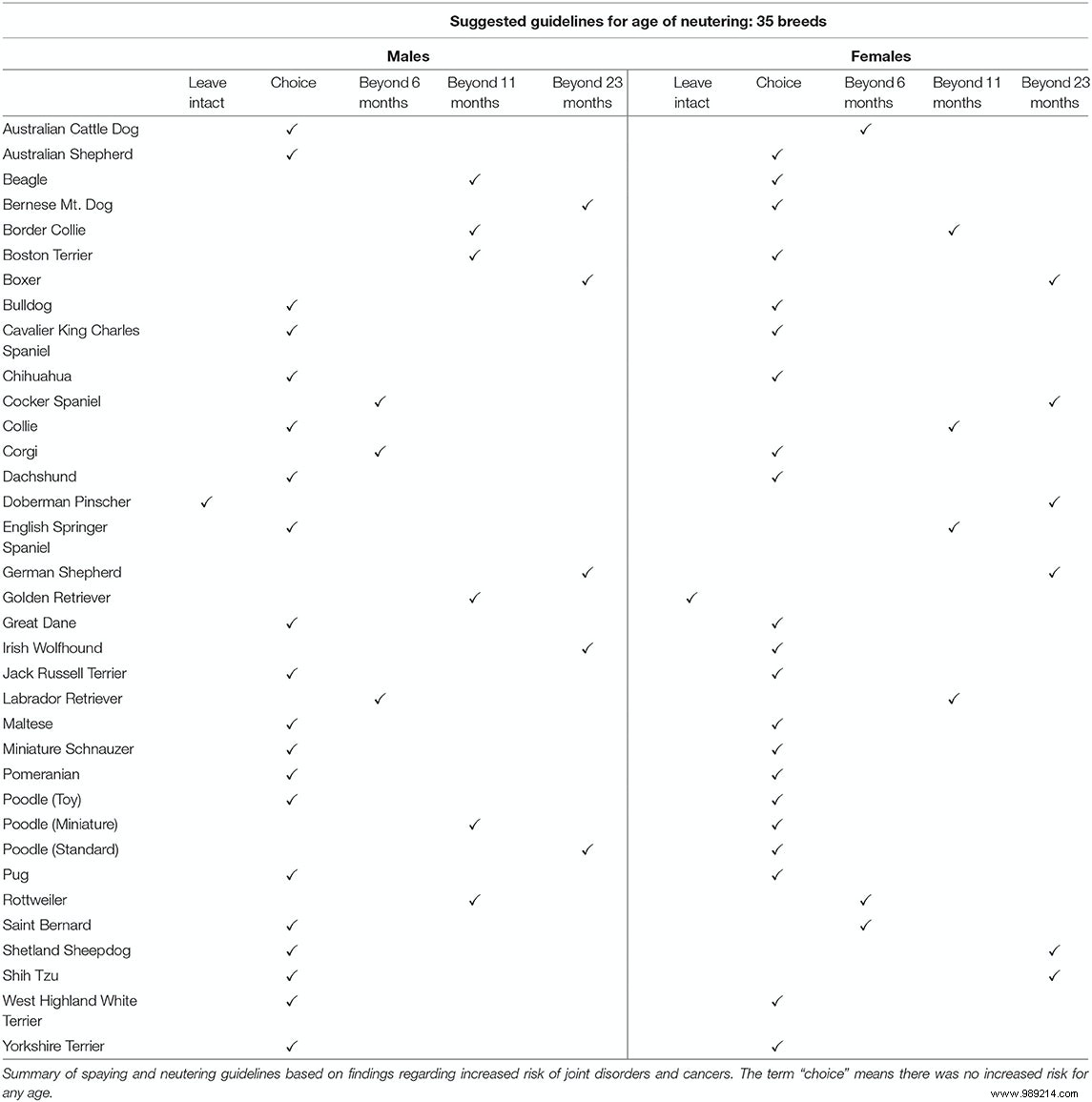Should you sterilize your dog in order to reduce the risk of possible health problems in the long term? A massive study published in Frontiers in Veterinary Science allows us to see a little more clearly.
Neutering both male and female dogs within the first year after birth has become common. However, we know that certain breeds are more prone to developing certain diseases or disorders if they are neutered before six months.
However, until now, studies have only assessed this risk for a few breeds. New work by researchers at the University of California (USA) has expanded this spectrum to 35 breeds . Finally, it appears that the vulnerability to sterilization varies considerably depending on the breed.
In this work, researchers analyzed 15 years of data from thousands of dogs admitted to UC Davis Veterinary Medical Teaching Hospital , in California. The goal:to determine if sterilization (and from when it is operated) can cause a particular breed to develop cancer or joint disorders .
More specifically, joint disorders here concerned hip dysplasia, cranial cruciate ligament tears and elbow dysplasia. In terms of cancers, the researchers looked at lymphoma, hemangiosarcoma (cancer of the walls of blood vessels), mast cell tumors and osteosarcoma (cancer of the bones).
Finally, the researchers also determined whether the sex of the animal could have an impact on the propensity to develop these different conditions.
The conclusion of this study, in a very general way, confirms that there is no generality .
"There is no 'one size fits all' when it comes to health risks and the age at which a dog is neutered , emphasizes Benjamin Hart, the main author of this work. Some breeds have developed problems, some have not. Some may have developed joint disorders but not cancer, or vice versa .
On the one hand, that the vulnerability of dogs to joint disorders is related to body size. “Smaller breeds have fewer problems , while the majority of larger breeds have them sums up Lynette Hart, co-author of the study.
The only exceptions were two giant breeds – Great Danes and Irish Sighthounds – which appeared to have no increased risk of joint disorders when neutered at any age.
The researchers also found that the frequency of cancers in small dogs was lower whether they are sterilized or not. In two breeds of small dogs, however, the data show a significant increase in cancers with neutering. These two breeds are the Boston terrier and the Shih Tzu.
Another important point:the sex of the dog sometimes makes a difference in the event of sterilization . A female Boston terrier spayed at the standard age of six months, for example, has no increased risk of cancer compared to an unspayed female. On the other hand, males of this breed sterilized before one year present a considerably increased risk.
Cases of cancer in larger sterilized dogs are therefore, as we have said, higher.
The study population was 220 uncastrated males, 203 castrated males, 128 unspayed females and 210 spayed females. The occurrence of one or more follow-up cancers in uncastrated males was 17% and in unspayed females 11%. Castration of males before two years of age significantly increased cancer risk compared to that of non-castrated males (+32%). Same pattern with sterilized females, with an increase in cancer risk of about 20%.
On this simple basis, the researchers therefore propose, for both sexes, to delay sterilization until the age of at least two years .

The sample included 318 uncastrated males, 365 castrated males, 190 unspayed females and 374 spayed females. In unspayed males and females, the level of occurrence of one or more joint disorders was 5% and 4%, respectively.
In males castrated before 6 months, the risks increased by 25%. Those castrated between six months and a year had a lower risk, estimated at 11%. In females, sterilization before 6 months was associated with 18% higher risks .
In addition, for uncastrated males, the risk of developing cancer was 15%. For unspayed females, the estimate was 5%. In contrast, males castrated before 6 months had a risk of developing cancer estimated at 19%. In females, sterilization before 6 months was this time associated with an 11% increased risk of cancer. Those sterilized between 6 months and a year had a 17% risk.
On this basis, if we obviously only take into account the risks of cancer and joint disorders, the researchers advise to sterilize males after one year, and not to sterilize the females .

To help owners determine the best way to keep their dog healthy, researchers developed a chart for each of the breeds studied (Beyond =from ).

Dog owners very often choose to neuter or neuter their pet to prevent pet overpopulation. To avoid overcrowding the refuges, in particular. But if the health of the animal is taken into account, this study suggests that dog owners should carefully reconsider.
“We believe that it is the decision of the pet owner, in consultation with their veterinarian, and not societal expectations that should dictate when sterilization , emphasizes Benjamin Hart. This is a paradigm shift for the most commonly performed operation in veterinary practice . »